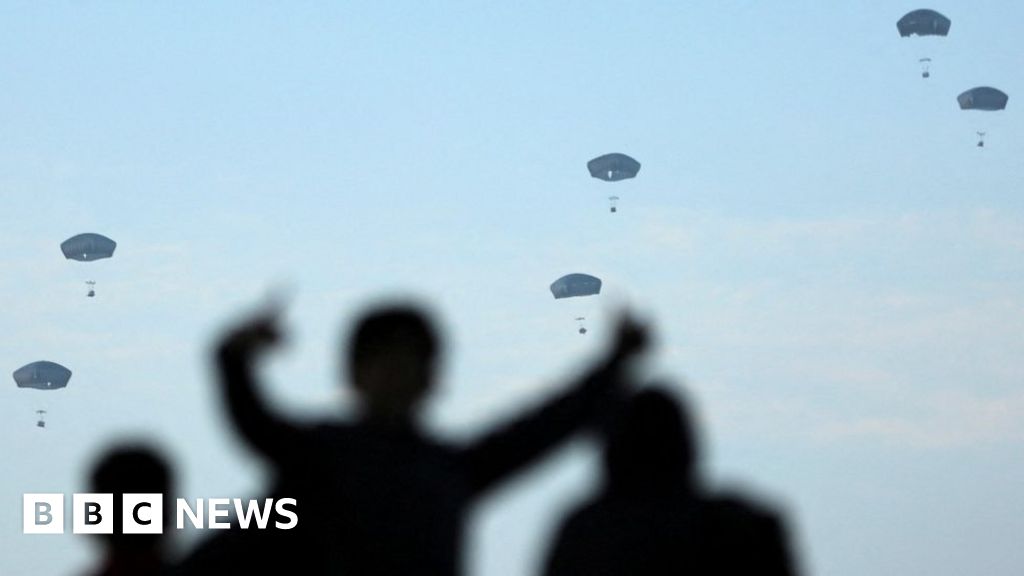Watch video: US parachutes humanitarian aid into Gaza
The United States carried out its first air drop of humanitarian aid to Gaza, parachuting more than 30,000 meals into the country on three military planes.
The operation was conducted jointly with the Jordanian Air Force and was the first of many announced by President Joe Biden.
The head of a well-known aid organization told the BBC he believed there was famine in northern Gaza.
At least 112 people were killed Thursday when crowds rushed into a relief convoy on the outskirts of Gaza City.
Hamas accused them of the killings. Israel denies this and says it is investigating.
The first U.S. air drop came as a senior U.S. official said the framework was in place for an agreement for a six-week ceasefire in the Gaza Strip.
Biden administration officials said Saturday that Israel had “more or less accepted” the deal.
“Starting today, there will be a six-week ceasefire in Gaza if Hamas agrees to release defined categories of vulnerable hostages: the sick, wounded, elderly and women,” the anonymous official said.
The mediators are scheduled to meet again in Cairo on Sunday, and Egyptian officials said delegations from both Hamas and Israel are expected to arrive for negotiations.
One official said certain technical issues surrounding a potential deal still needed to be resolved, such as how many Palestinian prisoners Israel would release in exchange for hostages held by Hamas.
U.S. Central Command said in a statement Saturday that C-130 transport planes dropped more than 38,000 meals on the Gaza coastline.
“These airdrops are part of continued efforts to obtain more aid to Gaza, including expanding aid flows through land and routes,” it added.
Other countries, including Britain, France, Egypt and Jordan, have previously provided airlift aid to Gaza, but this is the first time the United States has provided airlift aid.
Jan Egeland, president of the Norwegian Refugee Council, an aid group, has just returned from a three-day visit to Gaza.
Mr Egeland told the BBC on Sunday: “I was prepared for a nightmare, but it's worse, much worse.”
“People try to take your hand…saying, 'We're starving, we're dying here.'
“I think there is starvation in the north,” he said, adding that Israel had not authorized any aid and there had been no aid to the 300,000 people living in the ruins.
U.S. officials said Thursday's “tragic incident” highlighted “the importance of scaling up and sustaining the flow of humanitarian aid to Gaza in response to the dire humanitarian situation.”
Dozens of people are being treated at Al Shifa Hospital after Thursday's tragedy
Aid agencies say airdrops are an inefficient way to deliver aid.
“Airdrops are expensive, unplanned, and usually end up helping the wrong people,” Egeland said.
Medhat Taher, a displaced Gazan resident, told Reuters such measures were woefully inadequate.
“Is this enough for a school? Is this enough for 10,000 people?” he said. “It's better to use crosswalks to send aid than airdrops with parachutes.”
President Biden said in a statement Friday that the United States will “insist that Israel facilitate more trucks and routes to bring needed aid to more people.”
U.S. Vice President Kamala Harris will meet with Israel's wartime cabinet secretary, Benny Gantz, in Washington on Monday to discuss the cease-fire and other issues, Reuters reported, citing White House officials.
Thursday's incident left 112 people dead and more than 760 injured as they swarmed around an aid truck in the southwestern edge of Gaza City.
Israel said most of the soldiers were killed in the clash after warning shots were fired.
Giorgios Petropoulos, head of the Gaza office of the United Nations Coordinator of Humanitarian Affairs (OCHA), told the BBC that he and a team sent to Al Shifa hospital found a number of people suffering from gunshot wounds.
WATCH: Devastation after dozens killed in Gaza aid operation
Meanwhile, Hamas said on Saturday that at least 11 people had been killed by Israeli shelling at a camp in Rafah in southern Gaza. World Health Organization Director-General Tedros Adhanom Ghebreyesus said the attack was “outrageous”. The Israeli military said it had carried out “precision strikes” against Islamic Jihad militants in the region.
The United Nations' World Food Program has warned of impending famine in northern Gaza, which has received little aid in recent weeks and where an estimated 300,000 people live with little food and clean water.
After Hamas militants killed around 1,200 people in southern Israel on October 7 and took 253 hostages back to Gaza, the Israeli military launched a large-scale air and ground operation to crush Hamas. did.
The Hamas-controlled Gaza Health Ministry said more than 30,000 people have been killed in Gaza since then, including 21,000 children and women, about 7,000 are missing and at least 70,450 injured.


